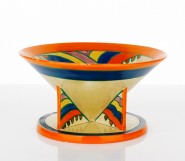Lot #65 - Ronnie (Tjampitjinpa)
-
Auction House:Mossgreen
-
Sale Name:Australian Indigenous & Oceanic Art
-
Sale Date:22 Jul 2014 ~ 6.30pm (Part 1 - Lots 1 - 198)
23 Jul 2014 ~ 2.30pm (Part 2 - Lots 199 - 331) -
Lot #:65
-
Lot Description:Ronnie (Tjampitjinpa)
(born circa 1943)
Tingari Ceremonies at the Waterhole Site of Pinari (1997)
synthetic polymer paint on linen
183 x 152 cm -
Provenance:Papunya Tula Artists, Alice Springs (RT970178); Gallery Gabrielle Pizzi, Melbourne; Private Collection, United States of America; Important Aboriginal and Oceanic Art, Deutscher and Hackett, Melbourne, 24 March 2010, lot 96; Private Collection, Brisbane
-
Notes:This painting is sold with a Papunya Tula Artists certificate which reads in part, "This painting depicts body paint designs associated with Tingari Ceremonies at the soakage site of Pinari, north of the Kintore Community. In mythological times a large number of Tingari Men travelled through this site during their journey further east." Ronnie Tjampitjinpa was born at Muyin, deep in sandhill country, just west of the Northern Territory/Western Australian border. He was initiated at Yumari, a rockhole associated with his uncle, the artist Uta Uta Tjangala. Later that year TjampitjinpaÕs family was surprised when a relative, Charlie Wartuma Tjungurrayi, appeared from the east leading a group of camels. Wartuma persuaded the group to return with him to experience life at the mission-run ration station at Haasts Bluff. And so it was that in 1956, Tjampitjinpa came into contact with the intercultural world that lay outside the dunefields of the Gibson Desert. Tjampitjinpa was among the youngest men to be involved during the first flush of painting at Papunya. However, instead of pursuing a career as an artist he chose to direct his considerable energy into operating an old red truck, running people and supplies to Yai Yai, 40 kilometres west of Papunya, an outstation where his people could escape the stresses of settlement life. Tjampitjinpa only recommenced painting after his return to Kintore in the early 1980Õs. Based on his home country, Tjampitjinpa assumed additional ritual authority, at the same time the demand for Pintupi paintings was increasing.1 His compositions grew in confidence and scale; by the end of the decade his signature style was apparent. Unlike the circles of most Western Desert artists, the concentric forms in TjampitjinpaÕs mature works are commenced with an oval or attenuated rectangular form. These forms are built upon methodically with contrasting bands of colour that pulse and jostle for space. TjampitjinpaÕs works are declarations of his unquestioned ceremonial authority in which optical effect is writ large. TjampitjinpaÕs works resonate with an architectural presence comparable to those of the young Frank Stella, utterly masculine and uncompromisingly assertive. John Kean 1 Daphne Williams in conversation with Sarita Quinlivan, in Unique Perspectives: Papunya Tula Artists and the Alice Springs community, Araluen Arts Centre, Alice Springs, 2012, p. 77
-
Estimate:A$30,000 - 50,000
-
Realised Price:
-
Category:Art
This Sale has been held and this item is no longer available. Details are provided for information purposes only.










